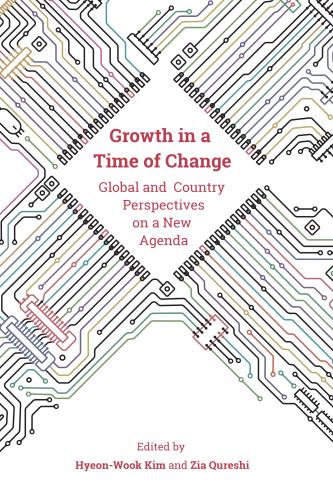This blog is part of a project exploring how the agenda for economic growth is being reshaped by forces of change, particularly technological change.
Economic growth has been lackluster for more than a decade now. This has occurred at a time when economies have faced much unfolding change. What are the forces of change, how are they affecting the growth dynamics, and what are the implications for policy? A recently published book, “Growth in a Time of Change,” addresses these questions.
Three basic ingredients drive economic growth—productivity, capital, and labor. All three are facing new challenges in a changing context. Foremost among the drivers of change has been technology, spearheaded by digital transformation.
Slowdown in productivity and investment
Productivity is the main long-term propeller of economic growth. Technology-enabled innovation is the major spur to productivity growth. Yet, paradoxically, productivity growth has slowed as digital technologies have boomed. Among advanced economies over the past 15 years or so, it has averaged less than half of the pace of the previous 15 years. Firms at the technological frontier have reaped major productivity gains, but the impact on productivity more widely across firms has been weak. The new technologies have tended to produce winners-take-most outcomes. Dominant firms have acquired more market power, market structures have become less competitive, and business dynamism has declined.
Investment also has been weak in most major economies. The persistent weakness of investment despite historically low interest rates has prompted concerns about the risk of “secular stagnation.” Weak productivity growth and investment have reinforced each other and are linked by similar shifts in market structures and dynamics.
Shifts in labor markets
Technology is having profound effects on labor markets. Automation and digital advances are shifting labor demand away from routine low- to middle-level skills to higher-level and more sophisticated analytical, technical, and managerial skills. On the supply side, however, equipping workers with skills that complement the new technologies has lagged, hindering the broader diffusion of innovation within economies. Education and training have been losing the race with technology.
Most major economies face the challenge of aging populations. Many of them are also seeing a leveling off of gains in labor force participation rates and basic education attainments of the population. These trends put an even greater focus on productivity—and technological innovations that drive it—to deliver economic growth.
Rising inequality
Growth has also become less inclusive. Income inequality has been rising in most major economies, and the increase has been particularly pronounced in some of them, such as the United States. The new technologies favoring capital and higher-level skills have contributed to a decline in labor’s share of income and to increased wage inequality. They have also been associated with more concentrated industry structures and high economic rents enjoyed by dominant firms. Income has shifted from labor to capital and the distribution of both labor and capital income has become more unequal.
Rising inequality and mounting anxiety about jobs have contributed to increased social tensions and political divisiveness. Populism has surged in many countries. Nationalist and protectionist sentiment has been on the rise, with a backlash against international trade that, alongside technological change, is seen to have increased inequality with job losses and wage stagnation for low-skilled workers.
Changing growth pathways
While income inequality has been rising within many countries, inequality between countries has been falling as faster-growing emerging economies narrow the income gap with advanced economies. Technology poses new challenges for this economic convergence. Manufacturing-led growth in emerging economies has been the dominant driver of convergence, fueled by their comparative advantage in labor-intensive production based on their large pools of low-skill, low-wage workers. Such comparative advantage is eroding with automation of low-skill work, creating the need to develop alternative pathways to growth aligned with technological change.
AI, robotics, and the Fourth Industrial Revolution
Technological change reshaping growth will only intensify as artificial intelligence, advanced robotics, and cyber-physical systems take the digital revolution to another level. We may be on the cusp of what has been termed the “Fourth Industrial Revolution (4IR).” And globalization is going increasingly digital, a transformation that, analogous to 4IR, has been termed “Globalization 4.0.”
Technological change recently has not delivered its full potential in boosting productivity and economic growth. It has pushed income inequality higher and generated fears about a “robocalypse”—massive job losses from automation. This should not cause despair, however.
Advances in digital technologies hold considerable potential to lift the trajectory of productivity and economic growth, and to create new and better jobs to replace old ones. As much as two-thirds of potential productivity growth in major economies over the next decade could be related to the new digital technologies. But technological change is inherently disruptive and entails difficult transitions. It also inevitably creates winners and losers—as does globalization. Policies have a crucial role to play. Unfortunately, they have been slow to adapt to the challenges of change. With improved and more responsive policies, better outcomes are possible.
An agenda to harness the potential of new technology
The core of the forward policy agenda is to better harness the potential of the new technologies. Reforms must seek to improve the enabling environment for firms and workers—to broaden access to opportunities that come from technological change and to enhance capabilities to adjust to the new challenges.
- Policies and institutions governing markets must keep pace as technological change transforms the world of business. Competition policies should be revamped for the digital age to ensure that markets continue to provide an open and level playing field for firms, keep competition strong, and check the growth of monopolistic structures. New regulatory issues revolving around data, the lifeblood of the digital economy, must be addressed. Flexibility in markets will be key to facilitating adjustments to disruptions and structural shifts from digital transformation.
- The innovation ecosystem should keep pushing the technological frontier but also foster wider economic impacts from the new advances. With the intangible asset of knowledge becoming an increasingly important driver of economic success, research and development systems and patent regimes should be improved to promote broader diffusion of technologies embodying new knowledge.
- The foundation of digital infrastructure and digital literacy must be strengthened. The digital divide is narrowing but wide gaps remain.
- Investment in education and training must be boosted and reoriented to emphasize the skills for the jobs of the future. With the old career path of “learn-work-retire” giving way to one of continuous learning, programs for worker upskilling and reskilling and lifelong learning must the scaled up. The key to winning the race with technology is not to compete against machines but to compete with machines.
- Labor market policies should become more forward-looking, shifting the focus from seeking to protect existing jobs to improving workers’ ability to change jobs. Social protection systems, traditionally based on formal long-term employer-employee relationships, should be adapted to a more dynamic job market. Social contracts need to realign with the changing nature of work.
- Tax systems should be reviewed in light of the new tax challenges of the digital economy, including the implications of the transformations occurring in business and work and the new income distribution dynamics. The potential tax reform agenda spans taxes on labor, capital, and wealth.
Reforms are needed at the international level as well, although the dominant part of the agenda to make technology—and globalization—work better and for all rests with policies at the national level. Not only must past gains in establishing a rules-based international trading system be shielded from protectionist headwinds, but new disciplines must be devised for the next phase of globalization led by digital flows to ensure open access and fair competition. Sensible policies on migration can complement national policies, such as pension reform and lifelong learning, in mitigating the effects of population aging.
The era of smart machines holds much promise. With smart policies, the future could be one of stronger and more inclusive growth.






Commentary
Technology and the future of growth: Challenges of change
February 25, 2020